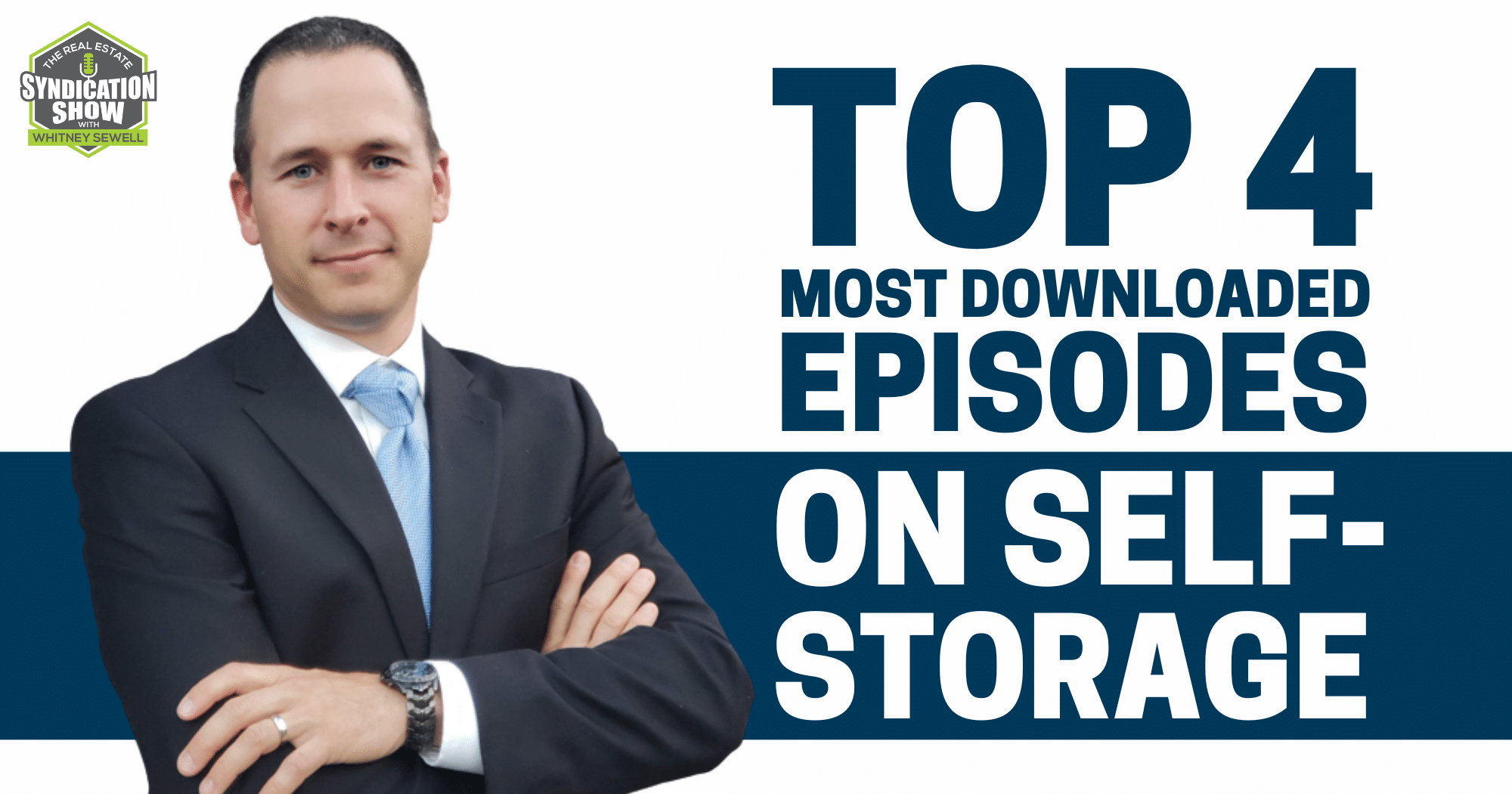In today’s episode, Paul Moore, Fernando Angelucci, Jacob Vanderslice, and Scott Krone take us back to the best episodes and takeaways about the lending environment. Paul discusses with Whitney the challenges in finding deals and the many opportunities to add value in self-storage.
Watch the episode here:
Listen to the podcast here:
Moving forward, Fernando talks about how self-storage is adapting to technology and why it remains to be an attractive investment opportunity. Meanwhile, Jacob shares the benefits of being in the self-storage space during the pandemic and Scott reminds us that aside from the market, we should also worry about the level of competition in the space.
Tune in now and get access to the best tips in the self-storage space just for free!
Key Points From This Episode:
- The number of self-storage facilities in the US and how did it give opportunities.
- How do you find value in self-storage and how can that grow your wealth?
- Why self-storage has been slow to adapt to technology but has still remained to be an attractive investment opportunity.
- The competition in the self-storage industry and how is it divided into two brackets: REITs or pseudo-REITs, and independent operators.
- What are the benefits of self-storage during the pandemic?
- The challenges of operating a fund and the risks of not being able to deploy capital.
- Why is competition the biggest hurdle in self-storage?
Tweet This!
“Self-storage, they don’t need to make increases in income because the cap rate compression has doubled, roughly, the value of their parts, just in five or ten years because of the popularity of this asset class.” – Paul Moore
“Another thing I really like in self-storage versus multifamily is that it has a very high sticky factor.” Fernando Angelucci
“Self-storage is a hyper-fragmented market. So to get to the point of competition that you are seeing in multifamily it’s going to take the big REITs they have to buy another 60, 70% of the market, which is not going to happen. It is just impossible to get to that many owners in such a short period of time.” – Fernando Angelucci
“We try to focus on markets with balance supply ratios, and markets with a subjective and objective low risk and the introduction of new supply, that might be because zoning is not receptive to self-storage, the city is not resettle storage.” – Jacob Vanderslice
“Self-storage was booming because it actually does better in recessionary market because as people reduce the size of their housing units, they put things into storage rather than getting rid of them.” – Scott Krone
Links Mentioned in Today’s Episode:
Wellings Capital Website and Resources
WS37: How to Discover Value Add Opportunities in a Hot Real Estate Market with Paul Moore
WS170: Paul Moore on Expanding The Multifamily Vision With Self-Storage And Mobile Home Parks
WS642: Paul Moore on Delaware Statutory Trusts
Fernando Angelucci on LinkedIn
Fernando Angelucci on Facebook
About Paul Moore
Paul Moore is the Founder and Managing Partner of Wellings Capital. After graduating with an engineering degree and then an MBA from Ohio State, Paul started on the development management track at Ford Motor Company in Detroit. After five years, he departed to start a staffing company with a partner. They sold it to a publicly traded firm for $2.9 million five years later. Along the way, Paul was a finalist for Ernst and Young’s Michigan Entrepreneur of the Year for two years straight. Paul later entered the real estate sector, where he completed 85 real estate investments and exits, appeared on an HGTV Special Real Estate episode, rehabbed and managed dozens of rental properties, developed a waterfront subdivision, and started two successful online real estate marketing firms. Three successful developments, including assisting with the development of a Hyatt hotel and a multifamily housing project, led him into the multifamily investment arena. Paul co-hosted a wealth-building podcast called ‘How to Lose Money’ and is a writer for BiggerPockets. Paul is the author of “The Perfect Investment – Create Enduring Wealth from the Historic Shift to Multifamily Housing” (2016) and “Storing Up Profits: Capitalize on America’s Obsession with STUFF by Investing in Self-Storage” (2021).
About Fernando Angelucci
Fernando Angelucci is founder and president of Titan Wealth Group where he leads the firm’s finance and acquisitions departments. He founded Titan Wealth Group in 2015 with Steven Wear, and under his leadership, the firm’s revenue has grown by over 100%. Prior to founding Titan Wealth Group, Fernando worked for Dow Chemical, a Fortune 50 company, rolling out a flagship product estimated to gross $1B in global revenues. With an engineering background, Fernando is able to approach real estate investing with a keen analytical mindset that allows Titan Wealth Group to identify opportunities and project accurate pictures of future performance. Fernando graduated from the University of Illinois at Urbana-Champaign with a B.A. degree in Technical Systems Management.
About Jacob Vanderslice
Jacob Vanderslice is Principal at VanWest Partners, a Denver-based real estate investment firm focusing on the acquisition and management of self-storage centers and other opportunistic real estate throughout the United States. By focusing on this conservative and growing real estate sector, VanWest has established a track record with over $195mm in real estate assets. Jacob and his partners’ success is driven by a commitment to delivering an expertly-executed, adaptable strategy with an institutional investment approach.
The diverse background of VanWest’s principle allows the company to look at investments outside the traditional, single focus strategy of many companies. Uncovering value when the value is not obvious allows Jacob and his team to maximize investment performance to their stakeholders. Jacob is passionate about educating investors about self-storage, urban infill repositioning, redevelopment of distressed commercial assets, and other non-traditional investment opportunities. He focuses on investments driven by data and reveals and maximizes opportunities to make a positive and lasting impact in the lives of his clients and investors.
About Scott Krone

Full Transcript
EPISODE WS1632
Whitney Sewell (WS): This is your daily Real Estate Syndication Show. I’m your host, Whitney Sewell. Today, I hope you enjoy some of our most downloaded episodes on self-storage.
[INTERVIEW 1]
Paul Moore (PM): Finding deals is so hard as you know, and as you’ve talked about on the show. So, we were not finding deals and I was really concerned that multifamily was just too overheated. We couldn’t find deals with a lot of value, a lot of meat left on the bone that hadn’t been improved. And we heard a statistic, in fact, that 93% of apartment buildings over 50-units have already had or are owned by professional multifamily operators or multi-asset operators at least who mostly have done all the value adds or at least most of them. Put that together with the fact that prices in many cases that we were seeing from brokers were 10%, 20%, 30% above what made sense on our models.
PM: And so, we discovered that self-storage, on the other hand, had 53,000 self-storage facilities in the US. That’s about the same as the number of Subway’s, McDonald’s, and Starbucks combined. But about 75% were run by independent operators, and two out of every
three of those were run by mom-and-pops. Now, it doesn’t mean they’re poorly run but it does typically mean that these mom-and-pops don’t have the desire, the knowledge, or the resources to make significant upgrades to increase income and to ultimately raise value and the value of the equity.
PM: So, we found this amazing opportunity in the arena of self-storage. And then, we discovered something very similar in mobile home parks, an area that had been looked down, you know, people look down their nose at mobile home parks, for years. But, there are about 43,000 mobile home parks in the US about 85% or 90% are owned by mom-and-pops. Like self-storage, they don’t need to make increases in income because the cap rate compression has doubled, roughly, the value of their parts, just in five or ten years because of the popularity of this asset class. So, they’re sitting pretty, being in many cases, mediocre and happy doing it. Well, there’s tremendous upside in deals like this. So, these are the two areas we focused on mostly with our five Wellings funds.
WS: Tell us a little bit about the value in self-storage or finding that value. How can that grow your wealth? How does that affect your business versus multifamily? What would you see there outside of just a better opportunity for acquisitions?
PM: When I first heard about value-adds and self-storage, I laughed. I think I really did. Because think about it, I mean, apartments have all these cool things. You can put in a dog park, you can add paint and wallpaper and fake hardwood flooring and beautiful cabinets and lighting. All these different things. But with self-storage, what are you talking about? I mean, we’re talking about four pieces of sheet metal, some rivets, a floor, and a door. Where’s the value in that? I mean, people sweep them out between tenants.
It just didn’t make sense to me but I had no idea what I was talking about. And so, a lot of my new book covers some of the value-adds in self-storage and we could take the rest of the show on this but a couple of quick examples are adding U-Haul.
PM: Now, if you add U-Haul, you are basically signing a contract with U-Haul putting the trucks out front. There are no capital expenses. My friend Todd Allen, you know Todd who owns Reliant, he has one self-storage facility that makes $5,000 a month in commission from U-Haul. Others make 1, 2, 3 thousand let’s say. Let’s say you can add $3,000 a month to your bottom line. Now, the value formula in commercial real estate which works for multifamily, self-storage, and others is that the value is the net operating income divided by the cap rate. So, if you can add $3,000 a month, that’s $36,000 a year. My mom always told me I was good at math, Whitney. Anyway, $36,000 divided by a 6% cap rate is $600,000 added to the bottom line. Well, I mean that’s the bottom line value. But if you have a $3-million facility that you just put a million dollars in equity and you borrow $2 million on, you just added 60% to the value of your equity by signing a contract with U-Haul and putting trucks out front. Of course, you have to do the work but there’s not much work.
PM: There are all kinds of other value-adds like adding a showroom, adding selling locks, boxes, tapes, scissors, adding late fees. Just raising rents using a dynamic rental management system where you basically, you know, you might charge a different amount for a 10-by-10 that’s in short supply in the marketplace. And you might, you know, then you wouldn’t have a five-by-five that’s oversupplied. You can actually move walls and change the size of units. You can add boat and RV parking. You can add climate-controlled units. You can add a propane-filling station, an ATM, a billboard, or a cell tower.
PM: There’s so much you can do to add value, and we call it intrinsic value extraction and here’s what I mean by that. A great operator, someone like you in multifamily, can look at a project and see opportunities that the previous owner didn’t care about or missed entirely. By adding those opportunities, they increase income and you can literally double or even triple the value of the equity over a few years.
[INTERVIEW 2]
Fernando Angelucci (FA): Another very interesting development in the self-storage space is technology. You know, where other asset classes have adopted technology rather quickly, self-storage has been one of those where it is taking quite a while for operators to adopt technology. So in just recently are we seeing man-less facilities where there’s a kiosk system to use to rent and purchase your unit, to purchase renter’s insurance and a lock and then you can use an app on your phone to open the gate, open your individual unit.
FA: You know, these are – it is interesting the technology that’s breaking into the space but again, it is one of those things where self-storage is a very hands-off type of business that I think a lot of operators have been hesitant to adopt these technologies, which in turn causes these technologies to be pretty expensive when they break into the market. There is an example – there is this one system that one of the largest providers of self-storage doors and
dividers provides, which allows all units in your facility to be controlled with a phone app.
FA: Right now, it is a little cost prohibitive because it costs about 300 to 350, 400 bucks a unit to install that but overtime as more investors adopt that technology and there is a scale associated with the vendor, we are going to start seeing those prices drop, right?
FA: Another thing I really like in self-storage versus multifamily is that it has a very high sticky factor. So what I mean by sticky factor is say I have a $150 unit. I can increase the rent on that $150 unit by $20 a month and that will be equivalent of a 13% increase to the bottom line. Now a renter is not going to take the time and then not only the cost to move to a new facility to save that 20 bucks. You know, if we are talking a solid 10 by 15 unit 150 square feet that means you are going to have to rent a truck, pay for the gas, pay for the time off to move there and for.
FA: Maybe get some helpers in moving in and out if they are not able-bodied. You know you are looking at $500 to a $600 cost to move to a facility over a $20 increase. It just makes more sense to stay there for an extra two or three years and absorb that. Now imagine if you tried to raise your monthly rent on one of your apartment units by 13%. Your tenants would immediately move out. I mean, when we were in the multifamily business and we are raising rents by 3% a year, we would get mass exodus from our units, because one of the things about self-storage versus multi families is that it is highly localized. For example, I am here in Chicago. I am in the near south side.
WS: Again, don’t buy in Chicago.
FA: Right but what I can do is if I didn’t like where I was living, I’d be willing to move to the north side of Chicago or the north-west side of Chicago. I am willing to go five to 10 miles away to get a good deal on an apartment, right? Whereas with self-storage, usually what we find is 90% of our tenant base comes from a three mile radius around our property. No one is going to drive 50 miles to go save an extra five to 10 bucks on a unit.
FA: Our tenants are much more sticky if you will and then the last thing that I really like about self-storage is the fact that you have multiple profit centers not just rent, right? I have a list here just some of the most common profit centers, ancillary profit centers that we had in self-storage, you can do car storage, boat storage, RV storage. We could sell locks, we could sell renter’s insurance and take a premium, you know maybe 60% of our renter’s insurance premiums come right back to us as the operator who is selling and pushing that product.
FA: We could sell moving supplies, packaging supplies. We can do FedEx, we can have printing services. We can add cell towers on our land, billboards that we can rent out. Truck rentals, private mailboxes, wine storage. The list goes on and that way I am not beholden to one way of making an income.
FA: You know, everyone that likes to talk about passive investments and talk about building a portfolio, they say, “You know it is all about multiple streams of income.” Now what if I told you that you can make five or 10 different streams of income off of just one real estate asset? That is much better than buying multifamily and the medical office and industrial property and single family homes and Airbnb’s and so it’s just one of those things where the more and more I looked at it, I just couldn’t not get into the space.
WS: How do you feel about the growing competition right now as far as lots of people trying to get into self-storage business right now or do you feel that that’s extremely competitive or how do you feel?
FA: Yeah, I mean I love it. So I break apart competition into two brackets. There is the REITs or the pseudo REITs, so these are the guys with the deep pockets and they are driving up rents in areas. I like when they come into an area near me. You know, I specialize in class B and class C properties and secondary and tertiary markets. So when a large REIT competitor moves into town they immediately raise all their rents for the entire market and all I have to do is I just piggyback off of their marketing so I don’t even have to pay for advertising and I just undercut their price by about five bucks per unit and now I am getting free leads coming my way because someone’s price sensitive and they’re shopping.
FA: Now on the lower rung, you have the newer investors coming into the space. I don’t really look at anyone of these people as competitors. I always look at everyone as a potential partner.
You know, these are investors that they want to learn how to get into the business, maybe they are buying their very first facility. Maybe they need help on their very first facility and they end up calling me in the markets that I am a heavy presence in and either bringing me deals, bringing me capital just to show them how to do the deals. Again, like I said before, self-storage is a hyper-fragmented market. So to get to the point of competition that you are seeing in multifamily it’s going to take the big REITs they have to buy another 60, 70% of the market, which is not going to happen. It is just impossible to get to that many owners in such a short period of time.
[INTERVIEW 3]
Jacob Vanderslice (JV): We were lucky we were in self-storage in 2020 and not more scaled up in our retail line of business because we got through it, a lot of our tenants suffered, and thankfully, we kept everybody except for one person, but self-storage did great during the pandemic and it continues to, and the reds or portfolio at the end of the 21 had a record occupancy growth from 21, 0-2020 to this year. And self-storage really benefits from disruption amiss like a pandemic or a recession, whatever might happen, because people get displaced and need places to keep their stuff. It’s out of sight, out of mind. Hits your credit card every month, and it’s been good to us in the downturn of 2020. Obviously, we’re all coming out of it right now, things are looking much better and other operators are reporting the same results, we’ve had great occupancy growth and great revenue growth, so we’re fortunate to be in an asset class that made it through as opposed to maybe a hospitality or to a degree, office and retail, self-storage. hanging there pretty well.
JV: Yeah, no, that’s great. And you briefly mentioned like read, how does something like this compete with a read… So deal flow has been one of our big challenges in 2021, and a lot of operators that are in real estate, we have capital allocations were maybe focused on hospitality, retail, other asset classes, they got a little more beat up till I wanted to put out… And now they’re in the self-storage business, so if it’s a widely marketed deal by a professional broker, there’s a call for offers, we can almost never compete because we’re trying to blend current deal with capital appreciation at the same time, we wanna distribute cash flow, but we also want upside. A lot of folks out there are only looking for you, they wanna eliminate during the life of the deal and sell it for a break even, and that’s the requirement. Others don’t care about cash flow, they’re banking on appreciation and cap rate compression, and we’re kind of trying to achieve both, so FAS been a challenge. If it’s a class, A multi-story climate-controlled deal on a primary market, we can’t compete, we can’t come close to the res public storage Extra Space, keep smart.
JV: They’re very aggressive right now. Most of our deals are in secondary, in tertiary markets, which are very overused words these days, ’cause we’re all doing deals in those markets, but we found those markets are a good blend of capital preservation, yield and appreciation. We’ve also found that the reds aren’t as competitive there, they’re not as active in those markets, places like pencil, Florida, suburban Charlotte, suburban Memphis, Tennessee, Columbus, Ohio, Detroit, Grand Rapids markets like the mortuary, and we’re not seeing as much re-competition, and so we try to fly to load their radar, and if we’re going to and to with them, we can’t get the deal.
WS: It’s good to just know that too, like, Hey, you’re competing with and help think through what market you’re in, what market there, and maybe that’s interesting and maybe you could provide a little more light there too, on just like picking the right location, how are you picking those locations for the find or not?
JV: Sale storage is very local supply-sensitive, so we track supply ratios in the 1 and 5-mile tree radius, nationally, there’s about seven square feet per capsular age across the US. Once you’re getting into some markets that are over 10 or 12, you start to see a decline in occupancy in revenues, and then Under 7, under 5, unless you start to see a much more volume occupancy and more boy in revenues and place rates. So we try to focus on markets with balance supply ratios, and markets with a subjective and objective low risk and the introduction of new supply, that might be because zoning is not receptive to self-storage, the city is not resettle storage. We also try to ideals at on a low replacement costs, so if a competitor does build a facility nearby, they’re asking rants need to be incrementally higher than our asking rents to achieve the sand Elon cost, but supply is really one of the big risks right now in self-storage and I think supply peak for the most part, in Q1 of 2020, there was a lot of new construction in 2019, so I never wanted supply and then beyond that, just good nuts and bolts, demographics and real estate, you don’t want an oppressive tax regime, you don’t wanna be in a municipality or a state that has a public lining population, you want density, you want rooftops and land, good locations, just like any other real estate deal applies for self-storage.
WS: And one thing I’m in to ask you earlier about the funds, and you were talking about the challenge of deal flow right now, I think that’s almost anyone in this business at the moment, or just the challenge of finding deals, good deals, I want something you can move forward on, but what… Operating a fund specifically, you raise all the money, you have this money, any risk of not being able to deploy it right now with just the challenge of not having good deals.
JV: Yeah, the day that our capital raising and our deal flow is it saying is probably gonna be never, it’s always too much of one and not enough of the other, and then the overnight that the pendulum shifts, we get a deal in our contract, we gotta hit the gas on capital raising. So we try to raise our capital kind of incrementally use, make acquisitions, what we’re not doing is going out and raising 30 million on January 1st and having it sit in the bank and then hoping to get it deployed, and so we try to balance our capital calls with their purchases, that stuff to do, it’s tough to do that. We’ve got investors who are about to sign documents, investors who have signed documents, maybe if you can’t fund on time and in everywhere in between, and figuring out that cadence is certainly a challenge.
WS: Yeah, no doubt about it. Well, I just think you just find more light there on, Hey, we don’t raise it all up front, We’re not just opening it completely day one, and I think it’s very smart. So how do you communicate that with investors to say, Hey, here it’s closed temporarily, or we’re gonna open it back up at a specific point. How do you do that?
JV: Well, one of the main reasons we don’t get to capitalize out of the gates is we wanna turn prefer return on what an investor funds or shortly thereafter, and obviously if somebody funds the entire capital stack on day one, there’s no income to pay, prefer return accumulates and that’s not a good thing for them or for the fund, so we’ll typically say, Okay, we’re raising 6 million in equity Forex acquisition, now that capital stack is full, but our next acquisition they’re after is 35, 40 days later, I get another 4 million grown then, so that’s how we communicate in where folks are coming in and win.
WS: Why go into the underperforming buildings and self-storage? Why not in a multifamily or original self-storage or –? What is it about that niche?
[INTERVIEW 4]
Scott Krone (SK): Well, I was in multifamily. I began in multifamily. My master’s thesis was a 400- residential-unit development on 50 acres that was close to a hundred million if not exceeding a hundred million dollars in revenue. The first part of my career or the first six to eight years was all in multifamily. Then after the crash, I also began buying distressed apartments. What we saw was that the cap rates were so compressed. It is very competitive and hard to get into that field.
SK: On the flipside during the crash, self-storage was booming, because it actually does better in recessionary market because as people reduce the size of their housing units, they put things into storage rather than getting rid of them. Then also, they’re looking to preserve. So self-storage historically has done better in a recessionary market than an expansion market. When I was first looking at self-storage, I was trying to find a distressed self-storage and I couldn’t find one, and that’s how I got into it.
SK: Now, the other side of it is comparatively more money is made in the development process than in the repositioning process. If self-storage is performing and you can only move it from, let’s say, a nine cap to an eight cap, you’re really not going to make that much margin in there, comparatively to the original class which is called the first-generation class C operations.
SK: What we’re dealing with is third-generation or class A, which is all environmentally controlled urban settings where you’re driving into the building, the garage door comes down, and you’re unloading your car in the building. Then you use a cart to distribute your goods into your locker. It’s an entirely different model than the original self-storage operations.
WS: Wow! You drive your vehicle in the building and unload. That’s interesting. Tell me about the risks that maybe an investor would be worried about in a type of asset like this.
SK: Well, every real estate has risks, right?
WS: Sure, every one.
SK: The thing that we like about self-storage is I don’t have to worry about color selections, no. Henry Ford was great with his quote that, “My buyers can have any color they want as long as it’s black.” For us, our clients can have any color of self-storage unit that they want as long as it’s white. The thing that they get to choose is what size, right?
SK: We eliminate the risk in terms of the finickiness of a buyer in terms of like liking brass or chrome or gold or any of those sorts of things. I mean, when we look at self-storage, it’s apartments without toilets. We’ve whittled this thing down to the most economic basic unit that we could possibly do. The biggest hurdle within self-storage is not the market. It is how much competition you have.
SK: And so, what we look for is when we’re going to areas, we’re setting the three and file-mile radius as to how much competition is in the marketplace. We can monetize that. We can analyze that in terms of what is the amount of self-storage in relationship to how many people. If we begin hitting our approach in a market, that means that our raise are going to come down and our lead times are going to expand and all those sorts of things. We like to go in the markets that have a heavy demand and not a whole lot of supply. That’s how we buffer against competition.
WS: What are some big mistakes you would say somebody starting to try to do what you’re doing would make as far – I mean, I can just imagine looking at this whole building and trying to assess, “Can we make a self-storage building out of this?”
SK: I mean, we were asked to look at one building that a person was evaluating in Cincinnati, and they thought an old parking garage is going to make for a good building. Well, in a parking garage, a lot of the floors are ramped so that you can get to one level to the next. The size of the elevator was small. The zoning wasn’t there.
SK: When we looked at each of these factors in the column layout, it made it very difficult. It made it hard to put self-storage in there and overly costly. We actually discouraged the person from going in that marketplace. The other one is if you don’t pay attention to the level of competition. We see people wanting to do this, and the metric is how many square feet of lockers per capita?
SK: This one woman who we were talking with, she’s like, “I own six acres, I’m going to make – I have a property in self-storage. It’s going to boom.” I asked her how much other competition was around her. She goes, “Oh! There’s not that much. There’s no other self-storage facilities around me.” I just did a quick Google search, and there was like 18 other facilities. Where market tends to supply or supply equals demand is around seven. Her facility was – Her location was already above nine without her adding a single square foot. I was like, “Whatever you do, do not put self-storage. It would be the absolute worst thing you could possibly do.”
[END OF INTERVIEW]
[OUTRO]
WS: Thank you for being with us again today. I hope that you have learned a lot from the show. Don’t forget to like and subscribe. I hope you’re telling your friends about the Real Estate Syndication Show and how they can also build wealth in real estate. You can also go to LifeBridgeCapital.com and start investing today.
[END]
Love the show? Subscribe, rate, review, and share!
Join the Real Estate Syndication Show Community:







